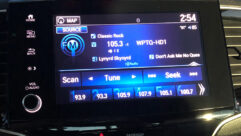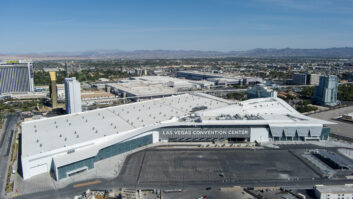(click thumbnail)Want to hear more-exciting sound in your station’s spots or in your on-air signal? This processor from Aphex will do the job, and then some.
The Aphex 204 Aural Exciter increases articulation and clarity on the high end, while its Optical Big Bottom enhances bass power and sustain on the low end – with only a small increase in signal level.
Aphex Systems has been making signal enhancers since 1975, and holds 20 patents on its technology.
The Aphex 204 can potentially benefit radio stations in several areas, particularly by adding some sparkle to muffled-sounding Webcasts. Spots may also sound more impressive both over the Internet and on air.
At clubs it can pump up disco music without damaging speakers.
Why not just turn up the bass and treble? Why not use a dynamic EQ or subharmonic synthesizer?
Aphex’s processing is not the same thing, and it has several claimed advantages.
(click thumbnail)The signal enters the 204 and splits into three paths.
Aphex advantage
The 204 includes two effects: Aural Exciter and Big Bottom. Your signal enters the 204 and splits into three paths: straight through to the output, through the Aural Exciter sidechain, and through the Big Bottom sidechain (Fig. 1). The sidechains signals mix with the unprocessed signal at the 204 output.
The Aural Exciter performs high-pass filtering on the signal, adds harmonics and frequency-dependent phase shift and mixes the processed sound at a low level with the original signal.
This processing is applied to low-level transients as well, a feature called the Transient Discriminate Harmonics Generator.
High-level sinusoidal waveforms are unprocessed to prevent overload. According to the manufacturer, the Aural Exciter increases the sense of presence, clarity, detail and loudness without significantly raising the signal level, and extends the high frequencies.
In contrast, enhancers with dynamic EQ boost the highs when the signal exceeds a certain threshold. But if the signal level is already high, this boost might overload power amps or speakers. Amplified high frequencies can add hiss as well.
The Big Bottom sidechain low-pass filters the signal, tweaks the phase vs. frequency and decreases the peak-to-average ratio (crest factor). The processed signal is mixed internally with the dry signal. Claimed advantages are enhanced bass punch and power with little increase in peak output.
Low frequencies in the sidechain are delayed and added to the original sound, which makes the bass notes last longer. Paradoxically, this does not change the original time relationship between the low frequencies and their harmonics, so there is no loss of low-frequency definition. Almost like Dolby noise reduction, low boost is applied to low-level signals, but not to high-level signals.
In contrast, bass enhancers with dynamic EQ boost the bass notes that exceed a threshold. Again, this boost can overload amps and speakers if the signal level is high. Subharmonic synthesizers generate signals an octave below the lowest frequency in the input signal. These ultra-deep lows require more amplifier power and can cause over-excursion in woofers.
In short, the Aphex 204 adds brilliance and bass power without clipping your transmitter, amps or speakers
Product CapsuleThumbs Up
Versatile tonal enhancement
Sounds better than EQ
Doesn’t cause clipping as
other processors can
Solid construction
Thumbs Down
May be easy to overuse (remember, a little goes a long way)
Price: $399
For more information contact Aphex Systems in California at (818) 767-2929, Fax (818) 767-2641 or visit www.aphex.com.
Features and hookup
When I unpacked the Aphex 204, I was impressed by its heavy, rugged construction and elegant appearance.
It is a two-channel device that can process stereo signals. The channel controls are not ganged. Filling a single rack space, the 204 includes six control knobs per channel on a matte silver front panel. Three knobs affect the Aural Exciter and three affect the Big Bottom.
Nominal settings for the controls are straight up – a thoughtful touch. Also on the front are two effects bypass switches, a power switch, and level indicators.
On the rear panel are XLR and phone-jack inputs and outputs. The jacks are wired TRS and can handle unbalanced or balanced signals. A +4/-10 level switch lets the unit work with either operating level.
The Big Bottom controls have Tune, Drive and Mix functions.
Tune varies the bass enhancement frequency band from 50 Hz to 190 Hz. The best setting depends on your sound system and type of music.
Drive sets optimum signal level according to a flashing LED.
Mix adjusts the amount of enhancement added to the original signal.
The Aural Exciter controls – Tune, Harmonics and Mix – work similarly.
Tune varies the corner frequency of the highpass filter, which sets the range of enhanced frequencies. Range is 800 Hz to 6 kHz, 3 kHz nominal.
Harmonics adjusts the level of harmonics or “edge” added to the signal.
Mix varies the amount of enhancement mixed with the original signal, like a dry/wet mix control on a reverb unit.
Normally you patch the Aphex 204 in line with the signal you want to process. Connect it between a tape track and a mixer, or between the air console and transmitter. Or connect the 204 between a channel’s send/return insert jacks.
If the mix controls on the 204 are set full clockwise, the unit will work in an effects loop, but that is not the recommended way of using it.
The manual that comes with the 204 is as good as it gets. Clear, thorough and attractive, the manual has helpful sections on applications, balanced/unbalanced lines, hum and grounding, and interconnection techniques.
In use
Aphex recommends setting the Aural Exciter and Big Bottom effects separately. Start with the mix control turned up to make the effect obvious, then back off to a tasteful amount of processing. As they say, “A little Aural Exciter goes a long way.”
I played several CD tracks through the 204 set to its nominal settings and listened for the difference with the effects switched in and out. Generally I heard more bass, deeper bass, and slightly brighter highs. How quickly the ear adapts to this! When I bypassed the 204, CD tracks that formerly sounded okay became thin, dull and lifeless by comparison.
It was fascinating to compare the Aphex processing with standard EQ. First I listened to a musical signal with the Big Bottom effect in its nominal setting. Then I ran the same signal through my mixer, and boosted 80 Hz until I heard the same bass boost that Big Bottom provided.
The EQ made the mixer meters peak about 6 dB higher, but Big Bottom raised the peak level only 1 or 2 dB. So, using the Aphex 204, you can get a fuller, stronger sound on the air without overmodulating the transmitter. The Big Bottom effect sounded less bloated than the EQ. The 204’s Tune control let me affect only the deepest bass notes if desired.
Similarly, I compared the Aural Exciter with a mixer EQ boost at 12 kHz. Adding EQ raised the mixer level about 5 dB, while the Aural Exciter raised the mixer level only 1 dB. Because I could tune the Aural Exciter to affect only the extreme top, it sounded airy and crisp without being harsh, unlike the 12 kHz shelving boost.
The Aphex processing sounded something like a selective, narrow-band EQ, but without ringing or peakiness.
Next, I wanted to see how the 204 might enhance the sound of a Webcast. Starting with a full-range musical program, I rolled off frequencies below 60 Hz and above 6 kHz using my mixer’s EQ. Then I put the equalized program through the 204 and converted it to a Real Audio file. The resulting file sounded fuller and brighter than the same file without processing.
Finally I tried the 204 on a portable disco system with moderate-size speakers. It sounded like I added a subwoofer! The bass became louder and deeper, even at quiet volumes.
The Aphex 204 is a solidly built, good-looking unit that can enhance the sound of various productions in your studio. It can even beef up your station’s on-air signal. Great job, Aphex.














